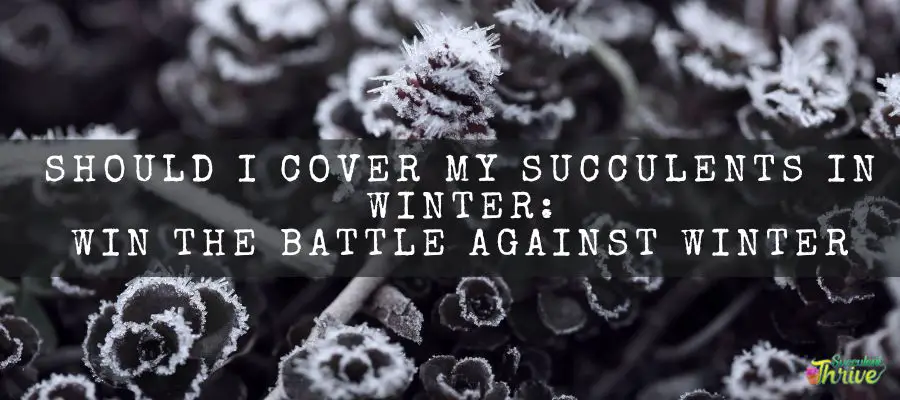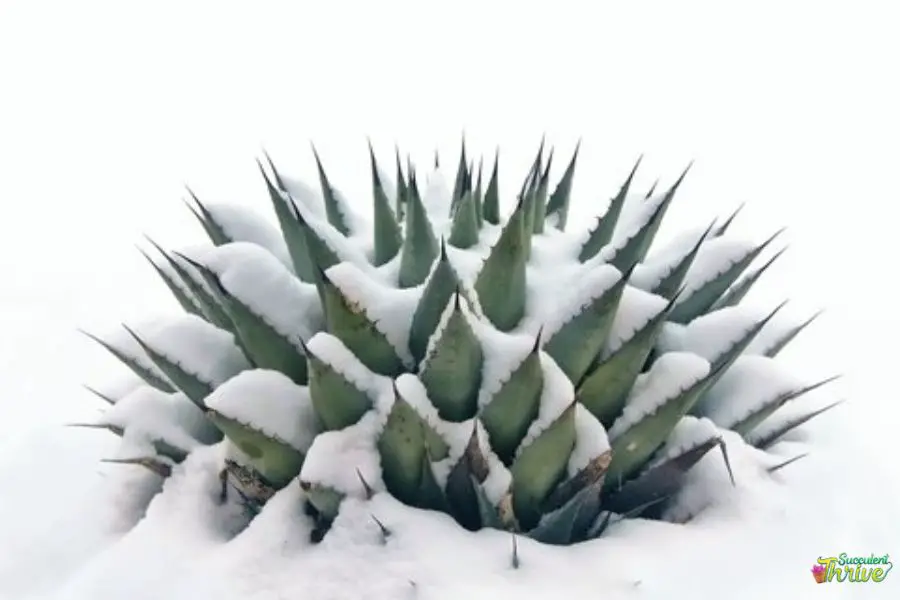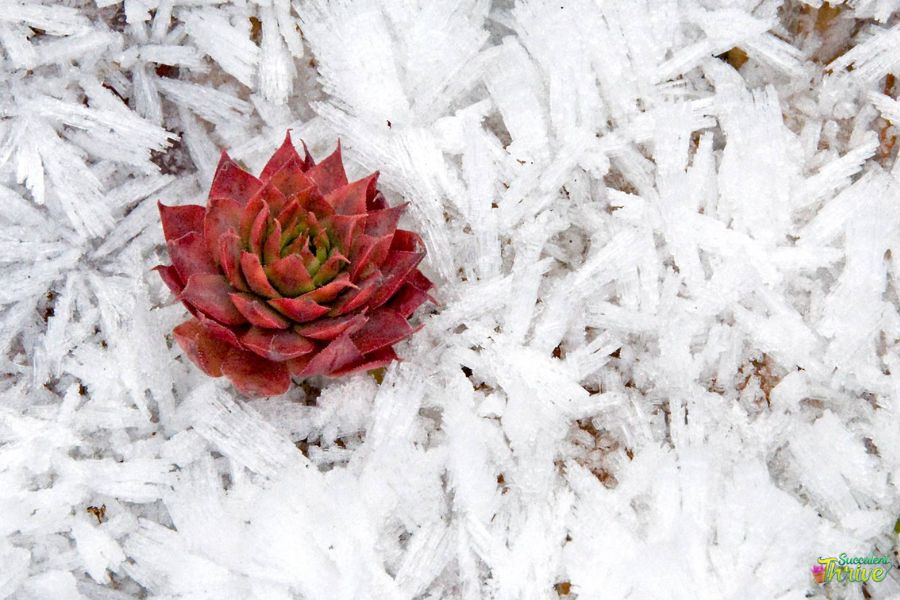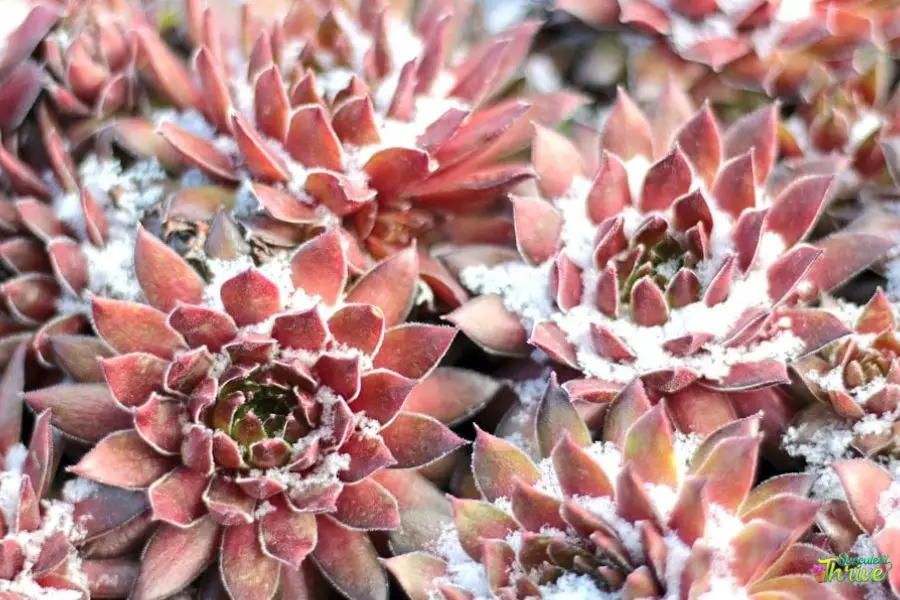Succulents are beautiful, hardy plants that can thrive in almost any environment. They require minimal maintenance and are easy to care for — but when winter comes, you will have the question ”should I cover my succulents in winter?” With the right guidance, you can keep your beloved succulents healthy and blooming all year long. In this article, we’ll dive into the ins and outs of protecting your succulent collection during the cold winter months.

Should I Cover My Succulents In Winter?
While some species of succulents can tolerate freezing temperatures, most need protection from frost and wind to survive the winter months. Fortunately, there are simple steps you can take to protect your precious plants from Mother Nature’s chill.
From choosing the right location to wrapping up plants with covers, this article covers everything you need to know about keeping your succulent collection safe in winter. Read on for advice on how best to care for these low-maintenance beauties when temperatures drop.
Importance Of Protecting Succulents In Winter
Protecting succulents during the winter months is important for both their health and continued growth. In order to do this, it’s essential to be aware of how cold temperatures affect them. Succulents need enough protection to survive the winter, otherwise they can die or become severely damaged due to frost and other environmental changes.
Providing protection from cold weather isn’t difficult; in many cases, simply moving the plants indoors is enough. If that’s not possible, covering them with a blanket or other material that blocks out the wind can help keep them safe and warm. Additionally, you should make sure your succulents get plenty of sunlight during the winter months – as well as making sure they don’t become waterlogged by over-watering.
It’s also important to note that some varieties of succulent are more prone to damage in cold temperatures than others. If you’re unsure which types of succulent are most likely to suffer from frost damage, it’s best to research the specific species before deciding whether or not they should be covered in winter. Ultimately, taking a few simple precautions can ensure that your succulents will make it through the colder months unscathed.

Understanding The Winter Climate For Succulents
When it comes to succulents, understanding the winter climate is key. Depending on where you live, winter can be mild or harsh. In warmer climates with mild winters, some succulents can withstand cooler temperatures and thus don’t need to be covered up. However, in colder regions, covering your succulents is essential for survival.
Figuring out what kind of weather your succulents are likely to face in winter is a great first step when it comes to deciding whether or not you should cover them. Most hardy succulents can handle temperatures as low as 20 degrees Fahrenheit, but more delicate species may need protection at higher temperatures. Knowing exactly what temperature your plants will be exposed to will help you determine how much protection they’ll need.
It’s also important to consider the amount of light and humidity during the winter months. Succulents rely on sunlight for photosynthesis and growth so they may require extra protection from sunlight during the shorter days of winter. Similarly, cold air tends to be drier than warm air which could cause issues for moisture-loving succulent species; a layer of protective fabric could help keep humidity levels high enough for these plants to thrive during winter months. Ultimately, understanding your local climate and the needs of your particular succulent species can help you decide whether or not you should cover them up this winter.
Factors To Consider When Deciding To Cover Succulents In Winter
When it comes to deciding whether or not to cover succulents in winter, there are a few key factors to consider. Firstly, you should identify the climate of your region. Different plants have varying requirements for temperature and humidity, so it’s important to know your specific environment. Secondly, you need to determine what type of succulent you own. Some varieties are hardier than others and can handle colder temperatures better. Lastly, consider the amount of sunlight available for the plant during winter months. If direct sunlight is limited or nonexistent, you may want to provide some protection from the cold weather.
In addition to looking at environmental factors, there are also practical solutions that can help protect succulents in winter. If you live in an area with harsh winters, investing in a cold frame or greenhouse can provide insulation from extreme weather conditions. You could also use row covers and other fabric materials to create a barrier between your plants and the elements. However, be sure not to trap too much heat as this can cause damage as well!
When making decisions about how best to protect your succulents in winter, there is no one-size-fits-all approach. Every situation is different and requires careful thought and consideration of all relevant factors before coming to a conclusion about when and how much protection is needed for your particular plants. Ultimately, it’s up to you to decide what works best for your particular needs and environment!

Types Of Covers For Succulents In Winter
When the weather starts to cool down, many gardeners find themselves wondering what to do with their succulents. Do you cover them in winter? If so, what type of cover should you use? Let’s take a look at some of the different covers that are available for succulents in winter.
The first kind of cover is a frost cloth. Frost cloths are made from breathable fabric and help to protect plants from freezing temperatures. They also provide an extra layer of insulation, allowing your succulents to stay warm and protected during the cold months. You can easily find frost cloths at most garden stores or online.
Another option is a plastic sheeting or tarpaulin. This type of cover can be laid over top of your succulents to keep them protected from any snowfall or hail storms. The drawback is that it doesn’t allow for much airflow and can cause oxygen deprivation if left on too long. It’s also not as aesthetically pleasing as some other options, so it might not be the best choice for gardens that will be visible from outside your home.
Finally, there are commercial covers designed specifically for succulents in winter. These covers typically come in various shapes and sizes and often include features like UV protection and drainage ports to keep your plants healthy during the cold months. They tend to be more expensive than other types of covers but they offer more protection against extreme weather conditions and last longer than other options.
No matter which type of cover you choose, it’s important to make sure it fits properly over your succulent plants so they don’t get damaged by any wind or precipitation. With the right care and preparation, you can ensure your succulents remain vibrant throughout the entire winter season!
How To Properly Cover Succulents In Winter
When it comes to covering succulents in the winter months, there are a few key steps to consider. Properly covering your succulents can provide them with the protection they need to survive the cold temperatures. It’s important to understand what type of cover is best suited for your particular succulent and how to properly protect it.
The first step is choosing the right kind of cover for your succulent. Depending on where you live, a plastic tarp or greenhouse might be necessary for more extreme climates. For less severe climates, a light blanket or fabric may be enough to guard against frost and wind damage. If you’re uncertain about what kind of cover is best for your area, speak with a local garden center or nursery for more information.
Once you’ve selected the right protective material, make sure it’s securely in place over your succulent before winter hits. This will help keep out drafts and moisture that could damage the plant during colder temperatures. Additionally, remember to check on your succulents periodically throughout the winter season and adjust their covers if needed.
With these simple tips in mind, you’ll be able to keep your succulents safe and healthy during winter months so they can thrive all year long!

Common Mistakes To Avoid When Covering Succulents In Winter
When the colder temperatures of winter come, protecting your succulents is essential to keep them healthy. But there are many common mistakes to avoid when covering succulents in winter. In this article, we’ll go over how to best protect your succulents and what you should avoid doing.
First off, be sure that you’re covering your succulents with something breathable and light-weight like a fabric or cloth. Succulents should never be covered with plastic or any other type of material that doesn’t allow air circulation. This can lead to suffocation and dehydration in succulents and can even cause them to die.
Another important factor to consider when covering succulents for the winter is temperature. If it’s too cold outside, your succulents may not survive the cold temperatures even if they are protected from the elements. Make sure to cover your succulent during only mild cold snaps and bring them indoors if temperatures drop too low for their liking.
Finally, it’s important to remember that some types of succulents don’t need any extra protection at all during the coldest months of winter. Check what type of succulent you have so that you know whether or not it needs additional protection from the cold weather before you take action. Taking these precautions will help ensure that your beloved plants stay healthy throughout the winter season.
Conclusion
In sum, there are a few important considerations to keep in mind when covering succulents in winter. It’s essential to take precautions so that the plants don’t become damaged by extreme cold or frost. Additionally, you should avoid overwatering and never cover succulents with plastic wrap or any material that won’t allow air circulation. Taking these steps will help ensure your succulents stay healthy during the winter months.
When it comes to protecting your plants from the elements, prevention is key. This means using proper techniques for covering and insulating them from the harsh winter weather. Take the time to research what type of protection is best for each succulent species and use the appropriate materials accordingly. It’s also important to check on your plants regularly during wintertime and remove any protective covers if necessary.
Ultimately, taking the right measures can make all the difference in protecting your succulents from winter damage. With some preparation and knowledge, you can give your plants the best chance of survival throughout colder months so they will continue thriving for years to come.
Read Next : Are Coffee Grounds Good For Aloe Vera Plants? ( No! )
